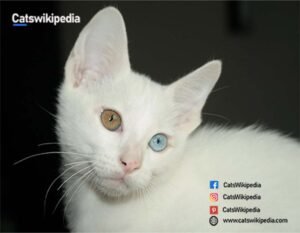KHAO MANEE CAT
BACKGROUND OF THE KHAO MANEE CAT
Most of these breeds were bred in Thailand and some are dead but most of it is still kept as a prized pet that adorns homes worldwide. There are only a few breeds of cats that have very little history, but the Tamra Maew, sometimes referred to as Treatise on Cats or Cat Book Poems, is an artful collection of descriptions and graphics of cats that is thought to have been printed around 1350 A.D. It has taught us much about the different Thai breeds of cats.

Still, others claim that Tamra Maew was the first breed standard for books describing a cat. This is because this book is accompanied by illustrations and information regarding the body of the cat.
There were approximately twenty different ancient Thai breeds that the Tamra Maew comprised, and only five have survived until today: the all-black konja, the silver-blue korat, the suphalak (Burmese), and the wichien maat (Siamese).
According to the Tamra Maew, there were said to be cats that were described as auspicious omens, which referred to bad luck. One of the most famous auspicious cats capable of bringing good luck is the Khao Manee. This is an odd-eyed cat said to be very auspicious.
Out of Thailand, the breed is rarely encountered. The first Khao Manee to be imported into this country was in 1999. The breed, in both the Cat Fanciers Association (CFA) and the International Cat Association (TICA), which employs the breed spelling “KHAO MANEE”, is recognized.
One does not require much grooming of a Khao Manees. However, its playful cat should have many toys to play with. Install a cat tree for them to climb so that their environment is also improved.
GROOMING
The Khao Manee breed is bred with a short, silky coat that sheds very little. This would be sufficient to keep it smooth and shiny with pretty loose hair-free. Frequent bathing every three to four months would keep up the pleasing texture, appearance, and scent.
A brightening shampoo, especially for white cats, would maintain the glossiness of the coat and preserve its color. Like any other cat, Khao Manee needs to have his nails trimmed every two weeks. Check weekly for dirt and debris in the ears, and clean them with a pet-safe ear cleaner if needed; bring it to the vet if you notice redness or dirtiness in the ears or when your veterinarian suggests so.
EXERCISE
The active, playful Khao Manee cat loves to explore and climb. Give your Khao Manee lots of interesting toys and things to look at and keep themselves occupied. Good toys for a Khao Manee include feather wands, bell balls, fuzzy mice, puzzle toys, and climbing and perching choices such as cat trees or towers. It’s said that Khao Manees enjoy playing fetch.
Keep your Manee Khao indoors. Since they are so rare and stunning, their owners are likely to fall prey to catnapping. But if your cat really wants to get out into the great wide yonder, there is a way to do this: you can take advantage of an outdoor enclosure or train it to walk on the leash with a harness.

TYPICAL HEALTH ISSUE
The breed of the Khao Manee is mostly healthy because very little was ever written about genetic anomalies that posed a problem for this breed.
Unilateral or bilateral deafness sometimes afflicts all-white cats, including the Khao Manee, with either one or both ears being affected.
LOOK AND APPEARANCE
A dog-sized cat, the Khao Manee has a long, sleek body and large, droopy ears. Not too large or chunky. It is also more adapted to Thai temperatures than is a short or snub nose of moderate length.
Their undercoat is thin to moderate, and they are short, smooth, fine, and just slightly “open.” Their eyes are often simply jewel tones-blue, gold, or green. Odd-eyed Khao Manees, said to be lucky, will have one of each.
NUTRITION AND DIET
Feed your Khao Manee measured meals at regular times. Adult cats should be fed at least twice daily, in the morning and evening, whereas kittens seem to thrive on three to four feedings per day. This will prevent the unwanted gain of weight since constant grazing, also known as “free feeding,” causes too many calories.
Any breed of cat is susceptible to diseases related to its weight, either being overweight or obese. Such diseases include diabetes, heart disease, and arthritis. Do not let this happen if you have an idea about how to keep your Khao Manee in the ideal weight. Consult an expert breeder or a veterinarian.

FAQ’S
1-How to Care for your Khao Manee?
It is a short-coated dog and needs very little grooming: his short coat only needs brushing once per week. In general, the average Khao Manee is an independent cat who does not generally require frequent bathing.
2-What is a Khao Manee?
The Pure white Khao Manee cats have a short, smooth glossy coat that lies close to the body having no undercoat. Khao Manee have nose leather and the paw pads that are both pink. They said to be lively, talkative, and bright. They are muscular, athletic cats of mild foreign type.
3-What Country does Khao Manee Belong to?
This breed is also known as the Cow Mane, and it is one of the older breeds of cats which originated from Thailand, dating back to several centuries.
4- What puts the Khao Manee at Risk?
Even though the exact population of this kind of cat is unknown, Khao Manee cats are almost extinct and prone to predation. They originate from some of the rarest breeds of cats in the world. To ensure that this breed line of the Khao Manee cat remains intact, a breeding system already exists for breeders working both in Thailand and in the West.



